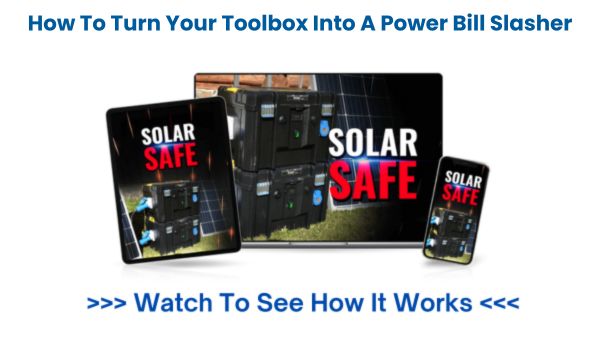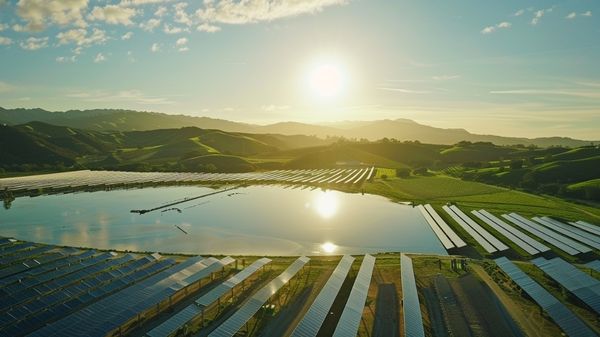Do you dream of harnessing the power of the sun to create your own off-grid paradise? Look no further, as this article will guide you through the process of building your very own DIY off-grid solar system. From selecting the right equipment and tools to understanding solar array design and choosing the perfect battery size, we’ve got you covered.
Join the ranks of self-sufficient individuals who have embraced the freedom and sustainability that an off-grid solar system provides. Let’s dive in and make your solar dreams a reality.

Key Takeaways
- Solar panels, inverters, batteries, and charge controllers are essential components of a DIY off-grid solar system.
- Designing and sizing the solar power system involves calculating the energy consumption of appliances, determining the maximum power draw and total energy consumed, and using these numbers to select the appropriate size of solar panels, inverters, and batteries.
- The selection of the inverter and charge controller should be based on their power and voltage compatibility with the panels and batteries.
- Proper cable sizing, correct installation, and thorough testing are crucial for the safe and optimal performance of the off-grid solar system.
Equipment and Tools for a DIY Off-Grid Solar System
The equipment and tools you’ll need for a DIY solar system include solar panels, an inverter, a battery, a charge controller, and wiring to connect all the components.
When designing your DIY off-grid solar system, it’s important to consider the best options available. Look for the best DIY off-grid solar system that suits your needs in terms of power capacity and efficiency.
DIY off-grid solar power systems are a great way to provide electricity in remote locations or reduce your carbon footprint. These systems allow you to generate your own power and be self-sufficient.
Related Article: DIY Solar Installation Made Easy: 10 Tools You Can’t Do Without.
Designing and Sizing the Solar Power System
To design and size your solar power system, start by listing all the appliances and their power and energy consumption. This will help you determine the total energy required for your DIY off-grid solar system. Use the following table to organize the information:
| Appliance | Power Consumption (W) | Energy Consumption (Wh) |
|---|---|---|
| Refrigerator | 150 | 1800 |
| Television | 100 | 300 |
| Lights (LED) | 10 | 120 |
Once you have the power and energy values for all your appliances, calculate the maximum power draw and total energy consumed in a 24-hour cycle. This will allow you to determine the size of the solar panels, inverter, and battery needed for your system.
Consider using DIY off-grid solar system kits, which provide all the necessary components for building your own system. With proper planning and sizing, you can easily build a DIY off-grid solar system that meets your energy needs and provides the freedom of generating your own clean and sustainable power.
Sizing the Solar Panels and Battery
Calculate the average sunlight hours in your location to determine the appropriate size for your solar panels and battery. To do this, follow these steps:
- Research the average sunlight hours in your area. This information can usually be found online or by contacting your local weather station.
- Use the following calculation: Total energy required (in watt-hours) ÷ daily sunlight hours = solar panel size (in watts).
- Select the appropriate solar panel size based on the calculation. It’s important to consider factors such as available space and desired energy output.
- Add a safety margin to ensure optimal performance. This will account for any potential variations in sunlight hours or energy consumption.
- Choose a battery size that can store the required energy. Consider factors such as battery capacity and voltage to meet your specific needs.
Related Article: Best Solar Panel Battery Bank for Home: The Ultimate Guide.
Choosing the Inverter and Charge Controller
When choosing the inverter and charge controller, make sure to select ones that have matching voltage ratings for the panels and battery. This is crucial for the proper functioning and efficiency of your DIY off-grid solar system.
The inverter converts the DC power generated by the solar panels into usable AC power, while the charge controller regulates the charging of the battery. It is important to match the PV input voltage of the inverter to the voltage of the solar panels, as well as the battery input voltage of the inverter to the voltage of the battery. This ensures compatibility and optimal performance of the system.
Additionally, check the specifications of the charge controller for current capacity compatibility with the solar panels. By choosing the right inverter and charge controller, you can ensure the smooth operation of your off-grid solar system.
Related Article: Solar Inverter String Design Calculations.
Cable Sizes and System Installation
Make sure you choose the appropriate cable sizes for safe and optimum performance when installing your DIY solar power system. Using the correct cable sizes is crucial to minimize power loss and ensure the safety of your system.
Here are some important considerations for cable sizes and system installation:
- Consult an online cable size guide for proper cable selection.
- Use appropriate cable sizes to minimize power loss and ensure safety.
- Ensure all equipment is correctly sized and ready for installation.
- Connect the components following a wiring diagram for correct power flow.
- Test the system after installation to verify its performance.
Introduction to Off-Grid Solar Power Systems
To get started with off-grid solar power, you’ll need to understand the basics of how solar energy from the sun can provide convenient and environmentally friendly power for remote locations. By harnessing the power of the sun, you can reduce your carbon footprint and have a reliable source of electricity wherever you go.
Off-grid solar power systems are ideal for RVs, campers, and outbuildings. They allow you to be self-sufficient and independent from the power grid. With a compact off-grid solar array, you can enjoy the convenience of power in even the most remote locations.
Not only will you have the satisfaction of belonging to a community of environmentally conscious individuals, but you will also have the peace of mind knowing that you are utilizing a sustainable and renewable energy source.
Benefits of DIY Off-Grid Solar System
- Convenient power in remote locations
- Reduces carbon footprint
- Belonging to an environmentally conscious community
- Sustainable and renewable energy source
Tools and Materials Required
You’ll need a cordless drill, socket set, and multimeter along with other basic electrical tools for the installation of your solar power system. Here are some tools and materials required for the DIY off-grid solar system:
- Basic electrical tools: These include wire cutters, wire strippers, and pliers for working with electrical connections.
- Heavy-duty lug crimpers: These are essential for crimping heavy-gauge lugs to ensure secure connections.
- Multimeter: This tool is used for measuring voltage, current, and resistance to troubleshoot and test the system.
- 1/0 gauge cable: This thick cable is necessary for connecting the solar panels, batteries, and other components.
- Shrink tubing: This double-walled adhesive-lined tubing is used to protect the crimped ends of cables, providing insulation and preventing moisture ingress.
Having these tools and materials will make the installation process smoother and ensure the proper functioning of your off-grid solar system.
Disclosure: We are participant in the Amazon Services LLC Associates Program, an affiliate advertising program designed to provide a means for sites to earn advertising fees by advertising and linking to Amazon.com.
Related Post: DIY Solar Panels Installation Made Easy: From Start to Finish.
Solar Array Design and Off-Grid Vs. Grid-Tied Systems
Now that you have a good understanding of the tools and materials required for building a DIY off-grid solar system, let’s dive into the topic of understanding solar array design and the difference between off-grid and grid-tied systems.
Understanding the Solar Array Design
Solar array design is the process of determining the layout and configuration of your solar panels. It involves considering factors such as the number of panels, their orientation, tilt angle, and shading. By optimizing the design, you can maximize the efficiency and output of your system.
Differences Between Off-Grid and Grid-Tied Systems
Off-grid systems are not connected to the power grid and rely on batteries to store excess power for use during the night or when the sun is not shining. They are ideal for remote locations where grid connection is not feasible.
On the other hand, grid-tied systems are connected to the power grid and use solar energy to power the home. They rely on the grid for power at night and during periods of low solar production. Excess power generated by grid-tied systems can be sold back to the utility company, reducing your electricity bill.
To help you visualize the differences between off-grid and grid-tied systems, here’s a comparison table:
| Keypoint | Off-Grid System | Grid-Tied System |
|---|---|---|
| Connection | Not connected to the power grid | Connected to the power grid |
| Battery | Requires batteries to store excess power | Does not require batteries |
| Reliance | Independent power source, suitable for remote locations | Relies on the grid for power at night and during low production |
| Excess | Excess power can be stored in batteries or used immediately | Excess power can be sold back to the utility company |
| Power | Provides power even during grid outages | Shuts off during power outages |
| Flexibility | Can be sized and designed based on specific energy needs | Limited by the size of the solar array and grid connection |
Understanding these differences will help you make an informed decision about which type of system is best for your needs. Whether you choose an off-grid or grid-tied system, both can provide you with the benefits of harnessing the sun’s energy and reducing your carbon footprint.
Choosing and Right-Sizing Batteries
When choosing and sizing batteries for your solar power setup, it’s important to consider factors such as customer support, charge cycle specs, lifespan, and amp-hour ratings. These factors will ensure that you have a reliable and efficient battery system that meets your energy needs. Here are some key points to keep in mind:
- Lithium iron phosphate (LiFePo4) batteries have high charge cycle specs and long lifespan, making them a durable and reliable option.
- Lead acid batteries are cheaper but have a shorter lifespan and are heavier, so they may be suitable for budget-conscious projects.
- Amp-hour ratings determine battery capacity, so it’s important to choose a battery size that can store the required energy for your system.
- Wiring batteries in series or parallel affects voltage and capacity, so you must consider the configuration that best suits your needs.
Related Post: DIY Solar Power Generator: An Affordable Way of Going Green.
Power Distribution Center, Cable Making, and Final Connections
To properly distribute power, make cables, and establish final connections, it is essential to have a power distribution center. This center includes a solar charge control module, power inverter, shunt, bus bars, and fuse block.
The power distribution center acts as the central hub for your off-grid solar system. It allows you to control and manage the flow of electricity.
- The solar charge control module regulates the charging of your batteries. This ensures optimal performance and prevents overcharging.
- The power inverter converts the DC power from your solar panels and batteries into AC power. This AC power can be used to power your appliances.
- The shunt monitors the battery charge.
- The bus bars provide a centralized connection point for all the system components.
- The fuse block protects against overloads and power spikes. This ensures the safety of your system.
Disclosure: We are participant in the Amazon Services LLC Associates Program, an affiliate advertising program designed to provide a means for sites to earn advertising fees by advertising and linking to Amazon.com.
Conclusion
Congratulations! You have successfully completed your journey into the world of a DIY off-grid solar system. Armed with the right equipment and tools, you have learned how to design and size your solar power system, select the perfect solar panels, inverter, and battery size.
You have also gained knowledge on choosing the right inverter and charge controller, as well as understanding cable sizes and system installation.
With this newfound expertise, you are now equipped to build your own off-grid solar system, harnessing the power of the sun to create a sustainable and convenient source of energy.
Just like a skilled craftsman, you can now confidently weave together the threads of technology and nature, creating an intricate tapestry of renewable power.
So go forth and let your creativity shine, as you embark on this exciting journey towards a greener future.




